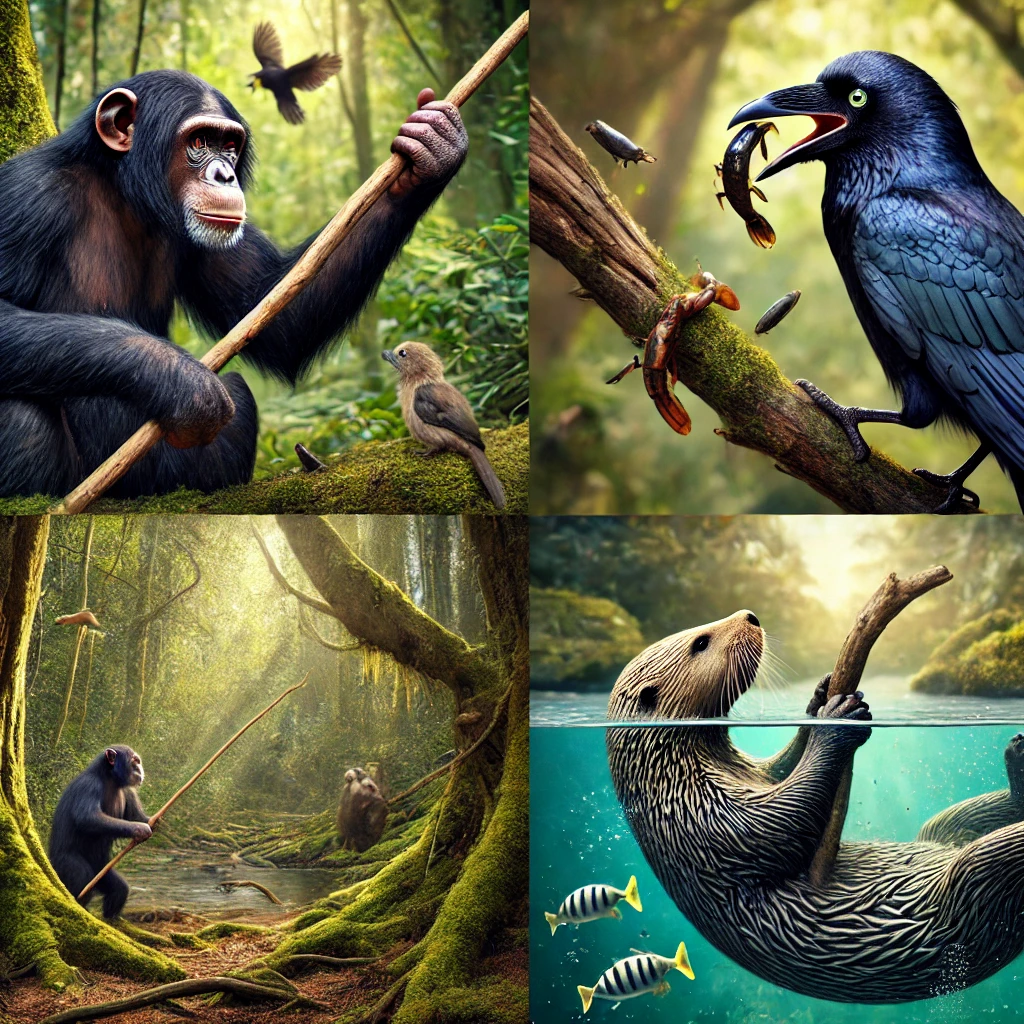How Do Animals Develop and Use Tools in Their Natural Habitats?
Introduction
Tool use in animals was once thought to be a uniquely human trait, but recent research shows that animals in various species develop and use tools in creative ways. From primates to birds, animals exhibit impressive problem-solving abilities, often crafting tools for tasks like gathering food, protection, or building shelters. This article explores how animals learn to use tools, the types of tools they create, and what tool use tells us about their intelligence and adaptability.
The Evolution of Tool Use in Animals
Why Do Animals Use Tools?
Animals use tools primarily to improve their chances of survival. Tools help them obtain food more easily, build protective structures, or even communicate. The evolution of tool use is often linked to an animal’s need to adapt to specific environmental challenges.
Cognitive Abilities Required for Tool Use
Tool use in animals involves several cognitive skills:
- Problem-solving – the ability to assess and tackle challenges.
- Learning and memory – retaining knowledge of tool-making and application.
- Flexibility and adaptability – using different tools for various needs.
These skills suggest that tool-using animals possess high levels of cognitive abilities, which often evolve in response to environmental demands.
Examples of Animals That Use Tools
Primates: The Original Tool Users
Primates, especially chimpanzees and orangutans, are known for their tool-using abilities. Jane Goodall’s groundbreaking studies observed chimpanzees in Tanzania using sticks to fish for termites, a behavior that challenged the notion that humans were the only tool users.
- Chimpanzees: In addition to termite fishing, chimpanzees use rocks to crack nuts and modify branches as spears for hunting smaller animals.
- Orangutans: Orangutans have been observed using leaves as gloves to protect themselves from thorny plants and crafting simple tools to access food in hard-to-reach places.
Birds: Master Toolmakers and Problem Solvers
Birds, particularly crows and parrots, display remarkable tool-using skills. They often exhibit behaviors that require intricate problem-solving and even foresight.
- New Caledonian Crows: Known for crafting complex tools, these crows use sticks and leaves to probe for insects. They are also capable of modifying natural objects to make tools that suit specific tasks.
- Woodpecker Finches: Found in the Galápagos Islands, woodpecker finches use cactus spines or twigs to extract insects from tree bark, showing impressive adaptability in tool selection.
Sea Otters: Tools for Feeding
Sea otters are marine mammals known for their clever use of rocks to open shellfish. They use these “anvils” on their bellies as a stable surface to crack open clams or mussels, showcasing tool use for feeding.
Dolphins: Creative Tool Use in Marine Animals
Bottlenose dolphins exhibit creative problem-solving by using marine sponges as protective “gloves” to shield their snouts while foraging on the seafloor. This behavior, known as “sponging,” protects dolphins from injury and helps them access food in rough terrain.
How Animals Learn to Use Tools
Innate vs. Learned Behavior
For some animals, tool use is an innate behavior, while for others, it is learned through observation and experimentation.
- Social Learning: Many animals, especially primates and certain bird species, learn tool use by watching other members of their group. Young chimpanzees, for example, observe adults using sticks for termite fishing and gradually acquire the skill through practice.
- Trial and Error: Some animals discover tools through trial and error. For instance, sea otters may experiment with different rocks until they find one that works well as an “anvil” for cracking shells.
Teaching and Cultural Transmission
In some species, tool use is passed down through generations, becoming a form of cultural tradition. For example, the use of sponges among dolphins is thought to be a learned behavior passed down from mother to offspring, illustrating the cultural transmission of tool use within marine environments.
The Impact of Environment on Tool Use
Resource Availability and Habitat
The development and complexity of tool use in animals are often influenced by their environment. Resource availability plays a significant role in encouraging tool use. Animals in habitats where food is scarce or difficult to obtain are more likely to develop tools to gain access to these resources.
- Example: Woodpecker finches in the Galápagos Islands use tools to access insects because food is relatively limited, driving them to be more resourceful.
Environmental Challenges
In addition to resource availability, environmental challenges like predators or difficult terrain can prompt animals to develop innovative tool-use techniques. Sea otters, for instance, use tools in part because it allows them to safely feed without risking exposure to predators.
What Tool Use Tells Us About Animal Intelligence
Problem-Solving Abilities
Animals that use tools exhibit impressive problem-solving skills. For instance, the New Caledonian crow’s ability to create multiple-step solutions for food retrieval demonstrates both foresight and adaptability.
Self-Awareness and Cognitive Flexibility
Tool use in animals also suggests a level of self-awareness and cognitive flexibility, especially when they adapt their tools to suit different situations. This level of flexibility indicates that some animals can adjust their behavior and tools based on their experiences.
Symbolic Thinking and Future Planning
Although future planning is largely attributed to humans, some animals seem to plan ahead with their tool use. For example, chimpanzees have been observed crafting tools and saving them for later use, a behavior that implies a degree of forward-thinking.
Fascinating Cases of Animal Tool Use
Crows Crafting Compound Tools
In a notable study, New Caledonian crows were observed using multiple tools in sequence, a behavior known as “compound tool use.” This behavior was once thought to be unique to humans, demonstrating the complexity of animal intelligence.
Dolphins and Sponging Behavior
The sponging behavior of dolphins is one of the few examples of marine animals using tools, showing that intelligence and problem-solving are not limited to land-dwelling animals. This behavior illustrates how unique environmental pressures can drive animals to innovate.
Chimps’ Hunting Tools
Chimpanzees have been known to fashion simple spears from sticks and use them to hunt small prey. This behavior indicates a level of predatory ingenuity and demonstrates the varied ways animals can use tools for survival beyond food gathering.
The Future of Research on Animal Tool Use
Expanding Our Understanding of Animal Intelligence
With ongoing research, scientists are beginning to understand that tool use among animals is more widespread and diverse than previously believed. This research sheds light on the cognitive abilities of animals, often blurring the line between human and animal intelligence.
Conservation Implications
Understanding tool use in animals also has implications for conservation. Protecting habitats where animals demonstrate unique behaviors, such as tool use, is essential for preserving biodiversity and supporting these species’ natural adaptations.
Technological Advances in Studying Animal Behavior
Technological advancements, such as high-definition cameras and tracking devices, allow researchers to observe animal behavior in greater detail, expanding our knowledge of tool use in species that were previously difficult to study.
Conclusion
Animals’ use of tools reveals remarkable cognitive abilities and adaptability across a wide range of species. From the complex tool-making of crows to the protective sponging behavior of dolphins, animals display intelligence and problem-solving skills that challenge our understanding of animal behavior. Observing and studying these behaviors not only deepen our appreciation of wildlife but also provide insights into the evolutionary origins of intelligence. As research progresses, we continue to discover the incredible ways animals interact with their environments, using tools to thrive in the natural world.
ChatGPT can make mistakes. Check important info.






